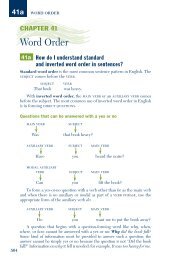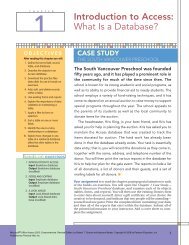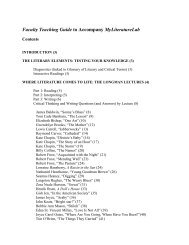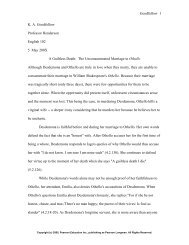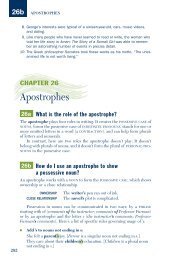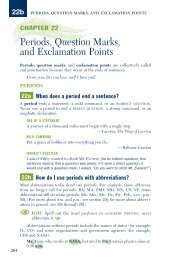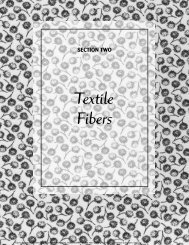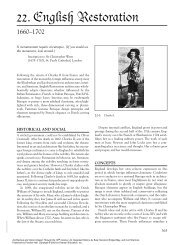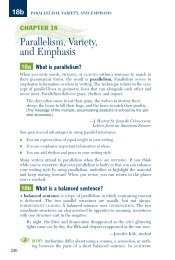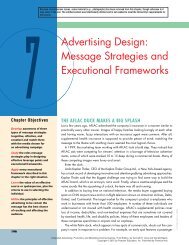JavaScript/JScript: Control Structures I - Pearson Learning Solutions
JavaScript/JScript: Control Structures I - Pearson Learning Solutions
JavaScript/JScript: Control Structures I - Pearson Learning Solutions
You also want an ePaper? Increase the reach of your titles
YUMPU automatically turns print PDFs into web optimized ePapers that Google loves.
2008934301<br />
Chapter 14 <strong>JavaScript</strong>/<strong>JScript</strong>: <strong>Control</strong> <strong>Structures</strong> I 401<br />
blame was pointed at the goto statement, which allows the programmer to specify a<br />
transfer of control to one of a very wide range of possible destinations in a program. The<br />
notion of so-called structured programming became almost synonymous with “ goto<br />
elimination.” <strong>JavaScript</strong> does not have a goto statement.<br />
The research of Bohm and Jacopini1<br />
had demonstrated that programs could be written<br />
without any goto statements. The challenge of the era for programmers was to shift their<br />
styles to “ goto-less<br />
programming.” It was not until the 1970s that programmers started<br />
taking structured programming seriously. The results have been impressive, as software<br />
development groups have reported reduced development times, more frequent on-time<br />
delivery of systems and more frequent within-budget completion of software projects. The<br />
key to these successes is that structured programs are clearer, easier to debug and modify,<br />
and more likely to be bug-free in the first place.<br />
Bohm and Jacopini’s work demonstrated that all programs could be written in terms of<br />
only three control structures,<br />
namely the sequence structure,<br />
the selection structure and the<br />
repetition structure.<br />
The sequence structure is built into <strong>JavaScript</strong>. Unless directed otherwise,<br />
the computer executes <strong>JavaScript</strong> statements one after the other in the order in which<br />
they are written. The flowchart segment of Fig. 14.1 illustrates a typical sequence structure<br />
in which two calculations are performed in order.<br />
A flowchart is a graphical representation of an algorithm or of a portion of an algorithm.<br />
Flowcharts are drawn using certain special-purpose symbols such as rectangles, diamonds,<br />
ovals and small circles; these symbols are connected by arrows called flowlines,<br />
which indicate the order in which the actions of the algorithm execute.<br />
Like pseudocode, flowcharts are often useful for developing and representing algorithms,<br />
although pseudocode is strongly preferred by many programmers. Flowcharts show clearly<br />
how control structures operate; that is all we use them for in this text. The reader should carefully<br />
compare the pseudocode and flowchart representations of each control structure.<br />
Consider the flowchart segment for the sequence structure on the left side of Fig. 14.1.<br />
We use the rectangle symbol (or action symbol)<br />
to indicate any type of action, including a calculation<br />
or an input/output operation. The flowlines in the figure indicate the order in which<br />
the actions are performed—first, grade is added to total,<br />
then 1 is added to counter.<br />
<strong>JavaScript</strong> allows us to have as many actions as we want in a sequence structure. As we will<br />
soon see, anywhere a single action may be placed, we may place several actions in sequence.<br />
Fig. 14.1<br />
add grade to total total = total + grade;<br />
add 1 to counter counter = counter + 1;<br />
Flowcharting <strong>JavaScript</strong>’s sequence structure.<br />
1. Bohm, C., and G. Jacopini, “Flow Diagrams, Turing Machines, and Languages with Only Two<br />
Formation Rules,” Communications of the ACM, Vol. 9, No. 5, May 1966, pp. 336–371.<br />
e-Business and e-Commerce: How to Program, by Harvey M. Deitel, Paul J. Deitel, and Tem R. Nieto. Published by Prentice Hall.<br />
Copyright © 2001 by <strong>Pearson</strong> Education, Inc.




